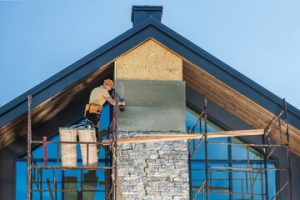Damaged masonry surfaces pose serious health and safety risks. When creosote and harmful gases build up in crooked, poorly constructed chimneys, they can leak into homes.
Chimney masonry repair services like tuckpointing, crown rebuilds, and wash rebuilds help restore structural stability and aesthetic beauty. They can also prevent water infiltration, which may lead to interior damage.

Tuckpointing
A chimney is a wonderful addition to your home, but it’s important to remember that it needs maintenance and repairs like any other part of your house. Your chimney’s brick and mortar joints are susceptible to damage from harsh weather conditions and repeated freeze-thaw cycles. These cycles cause the mortar to break down and expose your masonry to moisture infiltration that can lead to structural damage and interior water leaks.
Tuckpointing is a repair process that involves scraping and replacing old mortar between your bricks and re-creating a tight seal. Tuckpointing is the first step to preserving your chimney and keeping it safe and structurally sound.
While tuckpointing can be used to give your home a facelift and improve its aesthetics, its primary purpose is to help prevent moisture infiltration. Experienced masons use tuckpointing as the first step in a comprehensive masonry repair project.
Moisture can seep into a brick or stone wall through broken or deteriorating mortar joints, especially in buildings constructed of coal-fired brick in the 18th, 19th, and early 20th centuries. Tuckpointing helps to preserve the structural integrity of a historic brick building and prevents the costly consequences of moisture infiltration, including wood rot, mildew, mold, rusting metal, and crumbling or spalling brick.
Chimney Crown Rebuild
Chimney crowns are often the first part of a chimney to show signs of damage. They’re also the most difficult to repair because they require extensive masonry work and specialized coating materials. If left untreated, minor cracks in a chimney crown can worsen over time, leading to water penetration and costly repairs for the entire chimney system.
Your chimney crown is a concrete slab that sits over your flue opening and redirects smoke and gases out through the flue. It also protects the masonry and mortar joints from water, preventing it from seeping into your chimney, which can lead to brick erosion and even structural problems.
A damaged chimney crown allows rain, snow, and ice to penetrate your flue opening and weaken the masonry structure. It can also allow moss, fungus, and other debris to enter your chimney system, blocking the flue and causing safety hazards.
A skilled mason can seal small cracks in a chimney crown to prevent moisture from entering. For more severe damage, however, the most effective and reliable solution is to rebuild your chimney crown. This involves removing existing masonry, cleaning and preparing the surface, and replacing it with a specialized concrete that’s resistant to cracking. It can also be sealed with a protective coating to prevent future issues.
Chimney Wash Rebuild
Often, masonry repair and chimney services involve waterproofing. This service involves applying a breathable brick surface sealant to chimney surfaces, typically using a premium product with a 10-year warranty. This waterproofing solution prevents water from absorbing into brick surfaces, reducing the risk of cracking and spalling. It also allows internal water vapor to escape, which reduces moisture-related deterioration of the brickwork. This service is especially important for homes.
The chimney crown, also known as the chimney wash, is a layer of concrete or mortar that is applied to the top of a masonry chimney. It slopes down to direct rainwater away from the chimney, preventing water infiltration that can lead to structural damage and deterioration.
Over time, weather exposure and freeze-thaw cycles cause the crown to erode and crack, which allows water into the chimney. This water can damage the masonry and flue lining and seep into walls and ceilings in the home, causing stains and structural instability.
A reputable chimney service will diagnose the condition of the chimney crown and recommend the best course of action for repairs. A full chimney crown rebuild is a more expensive option, but it offers superior durability and resistance to weather conditions. A crown wash, on the other hand, is a more affordable solution that can be installed quickly. However, a crown wash requires more frequent inspections and maintenance to ensure that it is still providing protection from water damage.
Waterproofing
A chimney is more than just a beautiful accent to the exterior of a home; it’s a vital component of a home’s heating system, safely venting smoke and gases away from living spaces. However, exposure to harsh weather conditions and the deteriorating effects of time can take a toll on the chimney structure, leading to cracks, spalling bricks, water leaks, and other structural problems that could pose safety hazards for home occupants.
Chimney waterproofing can help protect the chimney from moisture damage and other costly repairs. Using advanced chimney waterproofing methods, professionals seal the brick surfaces with a breathable barrier that allows internal water vapor to escape, preventing the accumulation of corrosive salts in the masonry. The result is a stronger, more stable chimney that helps reduce energy consumption and extends the lifespan of the fireplace and chimney.
Reliable chimney maintenance companies offer a full range of services to keep fireplaces and chimneys in good working condition. Whether homeowners are dealing with creosote buildup, chimney leaks, or damaged chimney caps, top-rated specialists have the tools and experience to repair these issues effectively and efficiently.
Choosing the best chimney service providers should be based on their reputation, years of experience, and expertise in a wide range of chimney maintenance tasks. It is also important to choose a specialist who offers chimney liner repair services, as this will ensure that the chimney’s interior is protected from water damage.